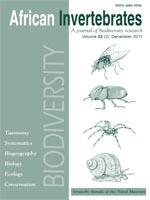Cithaeron dippenaarae sp. n. is described from both sexes. The species occurs in stony regions in the south of Morocco.
INTRODUCTION
The genus Cithaeron O. Pickard-Cambridge, 1872 presently includes six species: C. contentum Jocqué & Russell-Smith, 2011 from South Africa, C. delimbatus Strand, 1906 from East Africa, C. indicus Platnick & Gajbe, 1994 from India, C. jocqueorum Platnick, 1991 from Ivory Coast, C. praedonius O. Pickard-Cambridge, 1872 from Greece, Libya to Malaysia, Australia, USA, Cuba and Brazil, and C. reimoseri Platnick, 1991 from Ethiopia (Jocqué & Russell-Smith 2011; Platnick 1991, 2002; World Spider Catalog 2015). A seventh species, C. dippenaarae sp. n. is described in the present paper. A male and female were collected at localities approximately 350 km from each other, but in view of the small number of species in the genus, they are thought to belong to the same species.
MATERIAL AND METHODS
The material treated in this paper was collected during a field trip to Morocco. Specimens were examined and illustrated using a Wild M5 stereomicroscope. Further details were studied using an Olympus CH-2 stereoscopic microscope with a drawing tube.
Photographs were taken with a Moticam 5MP camera attached to a Realux stereoscopic microscope. Somatic morphology measurements were taken using a scale reticule in the eyepiece of the stereomicroscope and are in millimetres. Measurements of the legs are taken from the dorsal side.
Structures of the male left palpus are depicted. They were detached and transferred to glycerol for examination under the microscope. Female genitalia were excised using sharpened needles and then transferred to clove oil for examination under the microscope. Later, palps and epigynes were returned to 70 % ethanol. The type material is deposited in the Koninklijk Belgisch Instituut voor Natuurwetenschappen, Brussels (KBIN).
Abbreviations:
AE, AM, AL: anterior, anterior median and anterior lateral eyes.
PE, PM, PL: posterior, posterior median and posterior lateral eyes.
MOQ: median ocular quadrangle
Fe, Pa, Ti, Mt, Ta: femur, patella, tibia, metatarsus, tarsus.
Figs 1–12.
Cithaeron dippenaarae sp. n.: (1) male, dorsal aspect; (2) female, dorsal aspect; (3) male prosoma, dorsal view; (4) female prosoma, dorsal view; (5) leg of male, lateral view; (6) leg of female, lateral view; (7) male palp, ventral view; (8) idem, retrolateral view; (9) palpal tibia, retrolateral view; (10) epigyne, ventral view; (11) vulva, dorsal view; (12) idem, ventral view.

TAXONOMY
Family Cithaeronidae Simon, 1893
Genus Cithaeron O. Pickard-Cambridge, 1872
Cithaeron dippenaarae
sp. n.
Figs 1–16
Etymology: The species name is dedicated to our colleague Ansie Dippenaar-Schoeman from the Plant Protection Research Institute in Pretoria, in honour of her work on African spiders.
Diagnosis: Cithaeron dippenaarae sp. n. is easily distinguished from all other Cithaeron species by the strongly elongated cymbium and flattened bulbus in the male, and females by the position of the wide copulation ducts and spermathecae posteriorly to the epigynal hood.
Description:
Measurements: ♂: Total length 4.80; prosoma 2.18 long, 0.98 wide. ♀: Total length 6.80; prosoma 2.60 long, 2.02 wide.
Colour (female only, male is recently moulted and uniformly pale grey, Figs 1–4): Prosoma dark chestnut brown, with darkened striae; chelicerae as prosoma, distal third orange brown; sternum orange brown, slightly darkened at sides; legs yellow to orange brown, femora (especially Fe I) laterally darkened; palp of female light yellow; abdomen dark grey, posterior half with lobed, pale grey spot, not reaching spinnerets.
Prosoma: Fovea short, situated at posterior end of prosoma; anterior eyes rounded, posterior median eyes oval, posterior lateral eyes drop-like in male, rounded in female; AM on small blackened tubercles; both rows of eyes procurved. Eye measurements: Male: AM 0.12; AL 0.09; PM 0.17; PL 0.14; AM—AM 0.15, AM—AL 0.04, PM—PM 0.04, PM—PL 0.06; MOQ: length/width 0.10, anterior/posterior width 0.12. Female: AM 0.17; AL 0.13; PM 0.18; PL 0.10; AM—AM 0.10, AM—AL 0.025, PM—PM 0.02, PM—PL 0.02; MOQ: length/width 0.10, anterior/posterior width 0.11.
Chelicerae: With scattered black setae; fang short, cheliceral teeth absent.
Legs: Without distinct spines. Male tibiae apart from regular short hairs ventrally with a series of 12–15 irregularly placed longer hairs, continuing on basal third of metatarsi, much shorter or absent in females; distal 2/3 of metatarsi and tarsi in both sexes densely covered with short hairs (Figs 5–6).
Leg measurements:
Abdomen long oval.
Male palp (Figs 7–9, 13, 14): Tibia with short, retrolateral triangular apophysis. Cymbium elongated, three times as long as wide and three times as long as maximal diameter of bulbus; bulbus flattened, oval, 1.4 longer than wide; embolus semi-circular, situated at tip of bulbus, pointing in postero-ventral direction.
Female epigyne (Figs 10–12, 15, 16): With wide, triangular antero-median hood, bordering an oval, slightly depressed postero-median atrium; copulatory openings situated at lateral side of hood; vulva with wide semi-circular copulatory ducts, leading to wide, coiled spermathecae.
Holotype ♂: MOROCCO: Meknès-Tafilalet Prov.: 8 km south Rissani, road to Merzouga (31°17′05″N 04°09′13″E), 750 m, 21.iv.2012, leg. R. Bosmans, under stone (KBIN).
Paratype ♀: MOROCCO: Sous-Massa-Drâa Prov.: South Aït-ou-Mribete (29°53′36″N 09°35′36″E), 80 m, 27.iv.2012, leg. J. van Keer, stony river bank of Oued Massa, under stones (KBIN).
Distribution: Known from two localities in the south of Morocco (Fig. 17).
Biology: At both localities, the species was collected under stones in the vicinity of water bodies. The male and female were both collected in April.
ACKNOWLEDGEMENTS
Pierre Oger is thanked for providing us with the excellent photos. Tony Russell-Smith and an anonymous reviewer are thanked for their comments on the manuscript.








